How does the Architecture of urban space stimulate appropriation and manipulation of its fabric, symbols and language by its inhabitants, in unfamiliar, and ways otherwise overlooked? To what extent does the modern city support and suppress activities deemed to elapse the prescribed use of a space? Are these opportunities for engagement limitless? Does the modern city stimulate the cultural and physiological identity of its inhabitants?
Walk through urban space and you will undoubtedly see – and experience – what Borden refers to as “the left-over spaces of modernist urban planning”. (Borden, 2001, p.33) The spaces of decision-making, often characterised by excpansivity of space and signals. They are the spaces of the zero degree. (Borden, 2001, P.33)
These spaces contain a predetermined use, need and time, and contain within them objects with predetermined functions. While these zero degree spaces quietly serve their purpose, it is suggested they are being appropriated beyond their expected use, and are venerated with new meaning in the process – contrasting Lefebvre’s statement – where he maintains a lack of qualitative differences in the Architecture of the modern city and the experience of it is being reduced to “banal monotony”. (Borden, 2001).
The disciplines chosen are Skateboarding, Parkour and Guerilla Gardening. They have been chosen because they each contain within them the capacity to appropriate and re-programme spaces of prescribed function and use within the urban fabric of the modern city.
They also all contain within them a distinguishing feature, for example the Skateboarder reappropriates space with the aid of a tool (the skateboard) that is “absorbed into the body” (Borden, 2001, p.1).
Similarly, Parkour – a discipline reliant on an individual’s athletic ability and mental effort reappropriates space in much the same manner, however, the tool in this example is replaced by the motile body. Through a traceur’s (generally accepted term for a Parkour practitioner) efforts they “seek opportunities to remap their environment” (Angel, 2014, p.179) and in doing so form new “physical, spatial and psychological connections to it”. (Angel, 2014, p.179)
Finally, Guerilla Gardening is a discipline practiced by virtue of conviction. The movement is an attack on the scarcity of land within urban space, a battle for resources and ultimately a “fight for freedom of expression and for community cohesion”. (Reynolds, 2009, p.5)
Thus, the aims of the text are threefold. It will introduce, and thereafter explore the formal and material principles of the modern city to see how opportunities for engagement are presented.
Secondly, Skateboarding, Parkour and Guerrilla Gardening are introduced. A brief historical introduction set within the context of the modern city reveals the profound relationship between space and use. Thereafter exploring the spatial-political conflicts entrenched within their practice.
Finally, imagining these marginal users of space as performers and the transgressive, often illicit activities as urban performances, the text will explore how these modes of engagement can critique the modern city. Using Borden and Lefebvre’s theories and Tschumi’s ideology the text will argue the importance of such critiquing in informing the design and production of future cities.
1.2 Theory.
Its Tschumi’s perspective of Architecture, and of the experience of Architecture, and how he “locates transgression as a concept within Architecture” (Architectural Design, 2013, p.15) that forms the genesis of this investigative text.
The concept of transgression will play an important part for it will attempt to argue its importance in the context of the modern city – not conceptually and literally to Architecture and urban space as built form that negates its self – but rather a sociologically implied importance. Transgression formed of a series of transgressive acts that are performed within the modern city that consequently, highlight distinct ways contemporary counter-cultures are identifying with the built environment.
Get Help With Your Essay
If you need assistance with writing your essay, our professional essay writing service is here to help!
In pursuit of attaining a qualitative insight into the application of Skateboarding, Parkour and Guerrilla Gardening in the modern city the text will interpret the theoretical writings of Professor Iain Borden. An architectural historian and urban commentator. He is, at the time of writing, Professor of Architecture and Urban Culture at the Bartlett School of Architecture, UCL. His book “Skateboarding, Space and the City; Architecture and the Body” has proved invaluable in the production of this text. His theories on Zero degree Architecture, Rhythmanalysis and super architectural space – adopted from Henry Lefebvre, and adapted for understanding the urban practice of Skateboarding within the discourse of Architecture and urban space – are highly transferrable and form a theoretical framework to be used in understanding the socio-spatial impacts of non-normative, ludic activities being performed in the modern city.
1.3 Structure.
Section 1 introduces the main topics, the objective of the study, and informs the reader of the theoretical frameworks underpinning the text.
Section 2 formally introduces the three transgressive urban disciplines, their origins and historically roots them within the context of the modern City. The skateboard is introduced as a form of body-tool based engagement, Parkour; a body based engagement and finally Guerilla Gardening; a body-belief based engagement occurring with the urban realm.
Section 3 provides the reader with a brief historical development of the modern City, providing a brief exploration of the spatial and material qualities of 20th century Architecture, with particular emphasis on materiality, modernist urban planning principles, and the various architectural artefacts and quotidian objects that form the fabric of the modern city. The section ultimately explores the concept of the city as a collection of macro-micro spaces of opportunity.
Section 4 delves into Skateboarding, Parkour and Guerrilla Gardening’s political impacts on the modern City and its inhabitants. It explores the legislative measures, and design based tactics employed by authority to disrupt and halt activity. Thereafter, the text will explore conflict and ways in which it may be mediated/mitigated through design.
Section 5 explores explicitly the dialogue between Skateboarding, Parkour, Guerrilla Gardening and urban space, with the aim of revealing each disciplines unique spatial qualities, as well as the social, and spatial phenomena that occurs by consequence of their practice. The section will focus on exploring the way in which these modes of engagement can critique urban space, urban fabric, the wider city, its Architecture and inhabitants in new and unfamiliar ways.
Before we depart – Modern Architecture is a large subject that has been widely discussed and forms a large portion of contemporary architectural discourse. While it is, relatively easy, to obtain a comprehensive account of the Architecture that has pervaded the 20th century, it is, however, surprisingly more arduous to obtain an account of the public spaces that have emerged by consequence of its practice.
It is more difficult still to find critical analysis of urban space engagement that negates normative functions. (Preston, 1985)
It is far beyond the scope of this text to deliver the former; however, the text will endeavor to explore the phenomenon of human-urban interaction through the guise of a number of marginal urban cultural practices as they are enacted within the spaces between buildings.
2.1 Skateboarding
The street skateboard is many things, and serves various functions. For some, it is a form of transportation. For others, a tool that used to engage with the urban fabric of the modern city. For some it is both, and more, it is a way of life.
While it is impossible to pinpoint the exact date the Skateboard was invented, Borden suggests it originated in 1930-1950’s California. Quite different from the modern skateboard of today, they were makeshift contraptions that looked more like scooters. They were constructed by children using roller skates, apple crates and wooden planks and were used to traverse the suburbia sidewalks. (Borden, 2001, p.13)
Evenutually these homemade contraptions would evolve, loosing elements like the metal wheels which gave an uncomfortable and bumpy ride. They were eventually replaced with wheels made of composite materials such as plastic, clay and paper which gave the riders better traction and manouverability. (Borden, 2001, p.14-15)
The skateboard did not only evolve in its technological and material capacity, but also in the way it was utilised by the user. Most notable was the introduction of a manouvre called the “Ollie” which can be seen in figure 01.
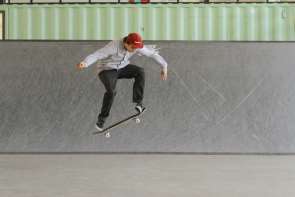
The ollie involves a series of explosive, perfectly timed manouvres produced with the intent of launching a Skateboarder in to the air, with the skateboard – the skateboard seemingly fixed to a skateboarders feet. (Borden, 2001, p.91) The feat which involves “a delicate relation between body, board, terrain and gravitational force” (Borden, 2001, p.91) would eventually develop into a “cornerstone of modern skateboarding” (Borden, 2001, p.91).
The popularity of Skateboarding has waxed and waned over the years. Arguably, it’s most important resurgence was in the 1980’s when a paradigm shift in the global skateboarding community occurred. Skateboarders, once content ‘surfing’ the sidewalk, carving the empty pools of California suburbia and navigating the constructed space of the Skatepark were instead being drawn to the oppertunities of the modern city. (Borden, 2001, p.23)
2.2 Parkour
According to the Oxford English Dictionary Parkour may be defined as a “discipline or activity of moving rapidly and freely over or around the obstacles presented by an (esp. urban) environment by running, jumping, climbing, etc” (Oxford English Dictionary , 2016)
Figure 2 shows a traceur leaping from one building to another.
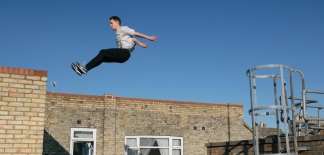
“Parkour is not merely about jumping over walls, despite some common misconceptions, it is an imaginative reworking of the existing spatial configurations as well as a reworking of the corporeal and a questioning of the self.” (Angel, 2014, p.178)
Much like modern street skateboarding, it may be argued Parkour is also synonymous with the the urban environment. Julie Angel, quoting Mathew Lamb goes as far as stating parkour is the “dialectical relationship between the built form and the body” (Angel, 2014, p.178)
Parkour is a comparatively new form of engagement with the urban and originated as a form of military training, first developed by French naval leutenant George Herbert. His anthropologial observations of the indigenous peoples of Africa and beyond – specifically their “physical development and movement skills” (Anon., n.d.) culminated in the formualtion of a physical training discipline refered to by Herbert as the ‘Natural Method’. (Anon., n.d.)
More recently two individuals – David Belle and Sebastien Foucan – developed their own versions of Herberts original physical discipline, they formed a group of practicioners which called themselves the ‘Yamikazi’. They would later develop a strong following in their home country of France and with the help of acclaimed film director Luc Besson, the introduction of Youtube and other pioneers of the mid noughties, Parkour would eventually cement its-self within contemporary culture and develop further into a globally recognised and occuring phenomenon. (Anon., n.d.)
3.3 Guerrilla Gardening
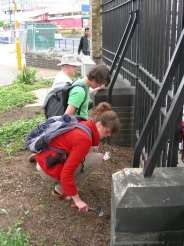
Guerilla gardening can best be described as “the illicit cultivation of someone else’s land” (Reynolds, 2009, p.05). The activity can be broken down into two leading constituents – guirella gardening for aethetics, and for hunger. The flora in an aethsetic context is regarded as the the guirella gardeners pallete, which is utilised in various ways to add personality and to articulate artistic expression in neglected urban space. Figure 03.
Others garden out of necessity in what Reynolds calls “people fighting for the right to have dinner on their plate” (Reynolds, 2009, p.14)
According to Reynolds no guerilla gardening manifesto exists, the activity is thought of as being a highly individual undertaking, with every gardener prescribing their own ethics, motivations and goals within their practice. (Reynolds, 2009, p.15) This however, isn’t explicily the case with some practicioners arranging “spectacular horticultural campaigns by organised and politically charged cells” (Reynolds, 2009, p.5)
As to the origins of guerilla gardening, one can assume – due to the nature of the subject, that is -Â cultivating land not belonging to oneself – that guerilla gardening has been occurring since at the very least, the Neolithic age, some 14,000 years ago. (Reynolds, 2009, p.65)
More recently there are well documented cases of the activity occuring within modern western cities such as New York, Paris and London.
3.3 Activating the modern city through activity
Why then, does our three transgressive, at times illicit activities form a viable and interesting topic within Architectural discourse?
For skateboarding, Borden suggests skateboarders have the ability to reject the Architecture and spaces of the city as a “coherent urban entity” (Borden, 2001, p.214)and instead view the saces of the modern city fabric as an orchestration of “floating, detcahed, physical items isolated from each other”.(Borden, 2001, p.214)
This is essentially the skateboarder reproducing Architecture and the city in their own image, and in doing so participate in an exercise of re-mapping the city, and forming a tactile languge made of objects, textures and surfaces that may be recalled at will when required. (Borden, 2001, p.14)
Ultimately the relationship between skateboarding and the modern city is highlighting how a space with a prescribed use is in reality inscribed with a multitude of uses.(Borden, 2001, p.247)
Julie Angel speaking of Parkour, argues that traucers “temporarily socially re-energises areas previously not used” (Angel, 2014, p.191) suggesting, “New encounters both socially and architecturally” (Angel, 2014, p.191) for the inhabitants of the modern city. Parkour thus forms an example of the modern cities inhabitants ascribing new significance, and meaning, to the zero degree spaces/quotidian functional objects of the modern city. (Angel, 2014, p.179)
For gurella gardening Olly Zanetti claims “gardening is at once a passive activity yet, in certain contexts, affords the ability to radically appropriate space” (Zanetti , 2007, p.17)
The above statements suggest the three transgressive activities exhibit a range of phenomena, however, they also share common themes. For example, they are all performed kinetically – throught movement and action – informing the dialectical relationship between Architecture, space and the body. (Angel, 2014, p.178)
Further, all three fit the definition of ‘play’, defined by the Oxford english dictionary as “Exercise, brisk or free movement or action”.(Oxford English Dictionary , 2016)
Rawilnson and Guaralda suggest play is “critical” (Rawlinson & Guaralda, 2011, p.1) to the wellbeing of the inhabitants of the modern city. Play also forms “new meanings and memories for normative elements” through an unconventional, and extraordinary level of interaction. (Rawlinson & Guaralda, 2011)
The above statements suggest the activities negate the prescribed use of space and are consequently venerated with new uses, meanings and memories in the process. May this suggests new spatial possibilities, opportunities, and futures for the inhabitants of the modern city?
3.1 Origins
According To Christian Norburg-Schulz – author of the book ‘Principles of Modern Architecture’ – Modern Architecture and thus the modern city which encapsulates it came into existence to help human beings feel more at home in the new world that had emerged with the arrival of the industrial revolution.
This new world was the by-product of major advancements in personal mobility, the new political and economic paradigms associated with the ‘new world’ structure and the arrival of what we would call today the ‘media’.
While the arrival of new technologies were a key precursor in the manifestation of the modern city, another constituent was the general rejection of custom and tradition by leading 20th century architects. (Norberg-Schulz, 2000)
This can be seen in advertisements and literature, such as this Deutscher Werkbund – (DWB) exhibition poster (Figure 4) promoting their ‘Form die ohne ornament’ (Form without ornament) exhibition in 1924.
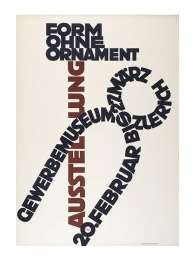
This new architectural doctrine promoted Architecture that embodied openness and transparency, with conceptions of space that extend in all directions and instill with in it a sense of infinity. (Norberg-Schulz, 2000).
3.2 MAteriality
“As various architects, theorists, and historians have pointed out, no material has been more closely associated with the origins and development of modern architecture” (Cohen & Moeller , 2006)
Cohen and Moeller are referring to concrete. It has been largely agreed that concrete has been synonymous with the modern architectural movement.
In terms of the development of our chosen transgressive activities in the modern city, the tactile material quality inherent of the modern city – be it the steel bollards obstructing vehicular access to a side street, or the granite benches of a piazza, or the in-situ re-in forced concrete floors and stairs of a regional building. Even the sculptural forms and surfaces orchestrating an Architectures external form and the pockets of green space that adorn it – they have all been exploited to great effect.
Also being utilized is the spatial organization of the modern city. With the process of urbanization comes its by-product – the movement and re-distribution of people from rural to urban. This equates to a greater density of people with in urban space and Architecture/public space must accommodate this increased density.
This is manifested through a principle of modernist/post-modernist design where-by notable spaces and architecture are linked by spaces designed for the movement/flow of large volumes of people. Interestingly these spaces which represent the “liminal exteriors of society” (Angel, 2014, p.178) are, according to Angel popular with traucers, the transitional spaces which “direct and steer the human subject” (Angel, 2014, p.178) using the available quotidian objects such as “Ramps, barriers and staircases” (Angel, 2014, p.178) are visual markers which influence and authorise their actions.
Such fragmentation of space is what bored Borden refers to as the “object-space-object-space rhythm born from a fragmentation of objects within a homogenous space” (Borden, 2001, p.195).
He maintains the spaces of the modern city that have evolved therein and importantly their potential for reappropriation can only have occurred in the ‘concrete city’ with its smooth surfaces and running spaces excaliming medievel, reinessance or early industrical cities are “crap to skate”. (Borden, 2001, p195) Borden is refereing to skateboarding in this instance, however, one can easily understand how his theory may be applied to parkour and even guirella gardening, for parkour is explosive, physical and requires the fragmentation of space, and guirella gardening gravitates to the neglected green spaces which adorn the zero-degree spaces of the modern city.
In respect of the above we can begin to view the modern city as the substrate from which a variety of different modes of self expression and identification with the urban environment may transpire.
This begs the question; how is the modern city liberated of its ludic duty – that is, the authoritative and cultural duty imposed upon it – and how is it reborn as the space of total opportunity?
For the answer we must understand how the practitioners of each identify with and seek opportunity from space.
For skateboarders, Borden believes, the modern city is presented as a pre-existent object, that’s liable to negation, specifically, throught expoliting its texcture. Texture in this context gives the skateboarder a different undersatanding of the modern city, an understanding informed from an expereince of surface and the tactility of materials. (Borden, 2001, p.194)
Engaging with the city on the level of textual terrain presents the Skateboarder with a myriad of physical sensations, inscribed with in the textual qualities of space that move up through the skateboard and is felt by the skateboarder, as well as heard.
The same can be said for the practice of Parkour, with the traucers intimate knowledge of the material and textual qualites of their immediate environemnt informing their movements and actions. For example, a sandstone ledge is a far safer landing pad in the wet than a polished granite one. This is arguably just one of countless material and textual judgements a traucer will make during a ‘session’. (Angel, 2014, p.181)
Gurella gardening is a different beast all together. While parkour and skateboarding both rely on and engage heavily with the textual fabric of the city, guirella gardening is more selective of it’s environemnt, for ovbious reasons.
Taking into account the particular activities that are happening within the modern city it may be argued the modern city’s image is revitalised and reborn through transgression. (Tschumi, 1996)
“There is no social or political change without the movements and programmes that transgress supposedly stable institutionality – architectural or otherwise; that there is no architecture without everyday life, movement, and action; and that it is the most dynamic aspects of their disjunctions that suggest a new definition of architecture” (Tschumi, 1996)
Tschumi initially implies that boundaries set by institutional orders, laws and codes must be transgressed if a new definition of Architecture and its associated meanings are to be developed. Thereafter he argues the importance of movement – the activation of bodies in space – to define Architecture.
However, how does movement, action and their disjunctions define Architecture, and why are they important, and who are they important to? The collective? The individual? The City? Architects and planners? It is beyond the scope of the text to fully answer such questions, however, a critical analysis of the spatial phenomena and politics concerning skateboarding, parkour and guerilla Gardening is conducted which forms a basis for further research.
4.1 Publicly private.
Various literature sources indicate a complex socio-political relationship between the chosen transgressive activities and the spaces occupying the modern city. Simpson suggests the “street is a palimpsest of laws, orders, codes” (Simpson , 2011, p.417) that contain within them the“potential for modification”. (Simpson , 2011, p.417)
One can understand the complications practitioners face during their day-to-day interactions with the modern city. This is largely due to what Simpson describes as the domestication of urban public space from the “incivilities or certain inhabitants through the regulation of difference” (Simpson , 2011, p.418) ultimately this domestication occurs to “exclude nonconsumers or those who are deemed to detract from the experience of that space” (Simpson , 2011, p.418)
Find Out How UKEssays.com Can Help You!
Our academic experts are ready and waiting to assist with any writing project you may have. From simple essay plans, through to full dissertations, you can guarantee we have a service perfectly matched to your needs.
View our academic writing services
Rawlinson and Guaralda suggest activities of “integrated play” (Rawlinson & Guaralda, 2011, p.20)must contend with – and thus be subordiante to -Â the authoritative powers in force, such as the government and the private institutions/bodies that own and maintain large percentages of cities. This suggests privately owned public spaces are dictated by a form of spatial politics which prioritises consumers over citisens. (Rawlinson & Guaralda, 2011, p.20)
This eventually leads to legislitave powers being drawn up, for example, legislature such as “provisions in â€-riot acts’, the use of â€-summary offences’ and restrictions on freedom of association and assembly in a public place” (Rawlinson & Guaralda, 2011, p.20) which aids in the restriction of activities which are deemend extraordinary or contradicttory to a spaces’ prescribed use.
Julie Angel believes this level of legislation against Parkour, for example, is due to the nature of the activity, she suggests “Private corporations fear the risk of liability to their organsiation” (Angel, 2014, p.188) which is understandable. The same can be said for skateboarding, both activities involve mass – bodies, objects and both, utilised in unison – operating at high velocities, and in close proximity to other users of the same urban space.
Skateboarding and Parkour are similar in their spatial politics, but what of Guirella Gardening?
In London the activity has “no legal protection“ (Zanetti , 2007, p.43) and further, Zanetti suggests the activity can “theoreticallly be construed as trespass theft or criminal damage”. (Zanetti , 2007, p.43), suggesting Reynolds ethic fits the definition of guerilla gardening exceptionally well:
“some people have a different definition of gardening. I am one of them. I do not wait for permission to become a gardener but dig wherever I see horticultural potential. I do not just text existing gardens but create them from neglected space.” (Reynolds, 2009, p.4)
4.2 Designed suppression
Angel quoting Michel Foucault suggests the Architecture and planning occurring within the modern city is underscored by a form of “spatial tactics” (Angel, 2014, p.184)as well as “political technology”.(Angel, 2014, p.184) Adding, methods used for the organization of bodies in space is conceived through “enclosure, partitioning and of creating functional sites”.(Angel, 2014, p.184)
What are these spatial tactics and what other tactics are employed to restrict one form of use over another?
Figure 5 illustrates a plan of the City Hall complex in London, containing the City Hall building designed by Foster & Partners. Adjacent to the building is The ‘Scoop’, an 800 seat external amphitheater designed by Townshend Landscape Architects. The ‘Scoop’ forms an interesting case study as it exemplifies the power struggle relations between space and non-prescribed use and reveals typical modes of designed suppression.
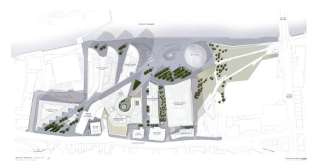
The polished steel knurls that adorn the external granite forms, as shown in Figure 6 are located to restrict the frictional, horizontal movement of metal objects, such as skateboard axles (trucks).
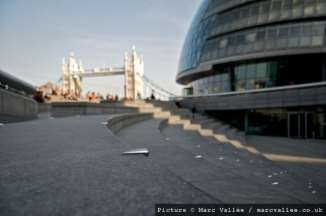
Figure 7 exemplifies the signage utilised by authority to forbid and criminalise non-normative activity. Interestingly, rollerblading as well as cycling – a generally accepted form of inner-city transportation is legislated against in this instance.
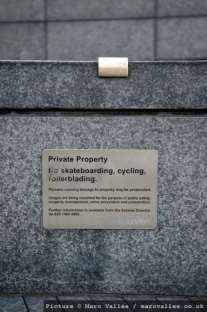
Thus presented are two examples demonstrating how architectural defense tactics have been employed demonstrating how owners, developers and governance “contribute to the maintenance of power of one group over another” (Angel, 2014, p.184)
The political and design based tactics restricting urban activities like skateboarding, rollerblading and ‘BMXing’ are not applicable with guerilla gardening. No examples of design-based tactics targeting gardeners explicitly have been found within academic literature.
4.3 Mediating conflict
A review of current literature reveals interesting ways in which the three transgressive activities mediate conflict within the modern city.
Whilst Borden suggests Skateboarding is “antagonistic towards the urban environment” (Borden, 2001, p.247) he presupposes skateboarders take advantage of the “bounded temporality” (Borden, 2001, 198) of certain spaces. He suggests skateboarders can mediate conflict with authority/building owners by choosing to use space at times when the adjacent buildings are not in use, such as at night or on weekends. Thus, skateboarders “substitute one temporal rhythm for another” (Borden, 2001, p.198) and in doing so animate the Architecture and spaces of the modern city at times when they would “otherwise go unnoticed” (Borden, 2001, p.198)
Skateboarders and traucers inevitably mark and scuff the surfaces they use to perform on, marks left by the skateboarders utherene wheels on the ground, damaged ledges from an accumulation of contact (Figure 8) and trainer marks are but a few examples worth noting. Whilst it’s understood skateboarders avoid conflict through clever use of temporal rythms, there’s no evidence within literature to suggest they take responsibility for the damage they inflict, as such one can assume they’re indifferent.
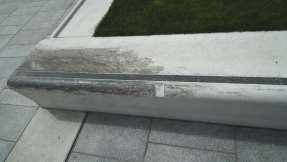
The same cannot be said for Parkour, however, with Angle suggesting traucers go to great lengths to make their relationship with the environemnt “a positive one” (Angel, 2014,p, 182) The residual build up of material that can make space look untidy has been “brought into question” (Angel, 2014, p.182) within the parkour community.
This has resulted in the “Leave no trace initiative”(Angel, 2014, p.183) (Figure 9) with traucers essentially chosing to paint over the marks their shoes leave behind, furthemore, traucers remove debris and litter before and after they practice, while they do this for their own safety Angel suggests Parkour “potentially improves spaces”.(Angel, 2014, p.182)
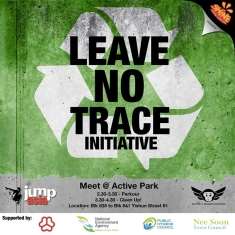
As previously mentioned guerilla gardening differs considerably to the two former transgressive activities in its theory and practice. It’s important to note that while the two former occur in plain view most of the time, it’s assumed guirella gardening does not. Guirella gardenings mediation of conflict is unequivocally linked to the activity, because o
Cite This Work
To export a reference to this article please select a referencing style below:
Give Yourself The Academic Edge Today
- On-time delivery or your money back
- A fully qualified writer in your subject
- In-depth proofreading by our Quality Control Team
- 100% confidentiality, the work is never re-sold or published
- Standard 7-day amendment period
- A paper written to the standard ordered
- A detailed plagiarism report
- A comprehensive quality report
Essay Writing Service
Essay Writing
Service
AED558.00
Approximate costs for Undergraduate 2:2
1000 words
7 day delivery
Order An Essay TodayDelivered on-time or your money back

1857 reviews

